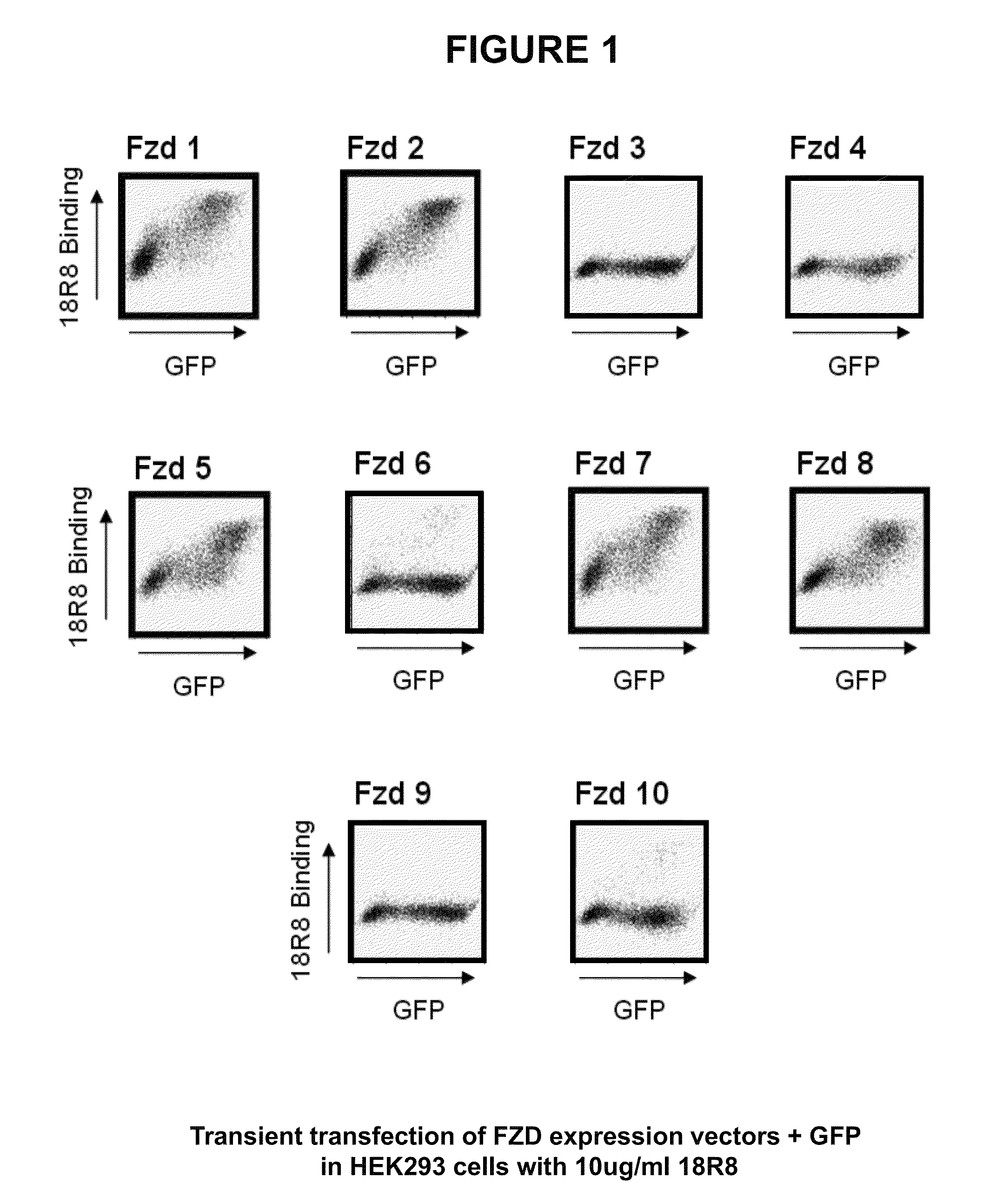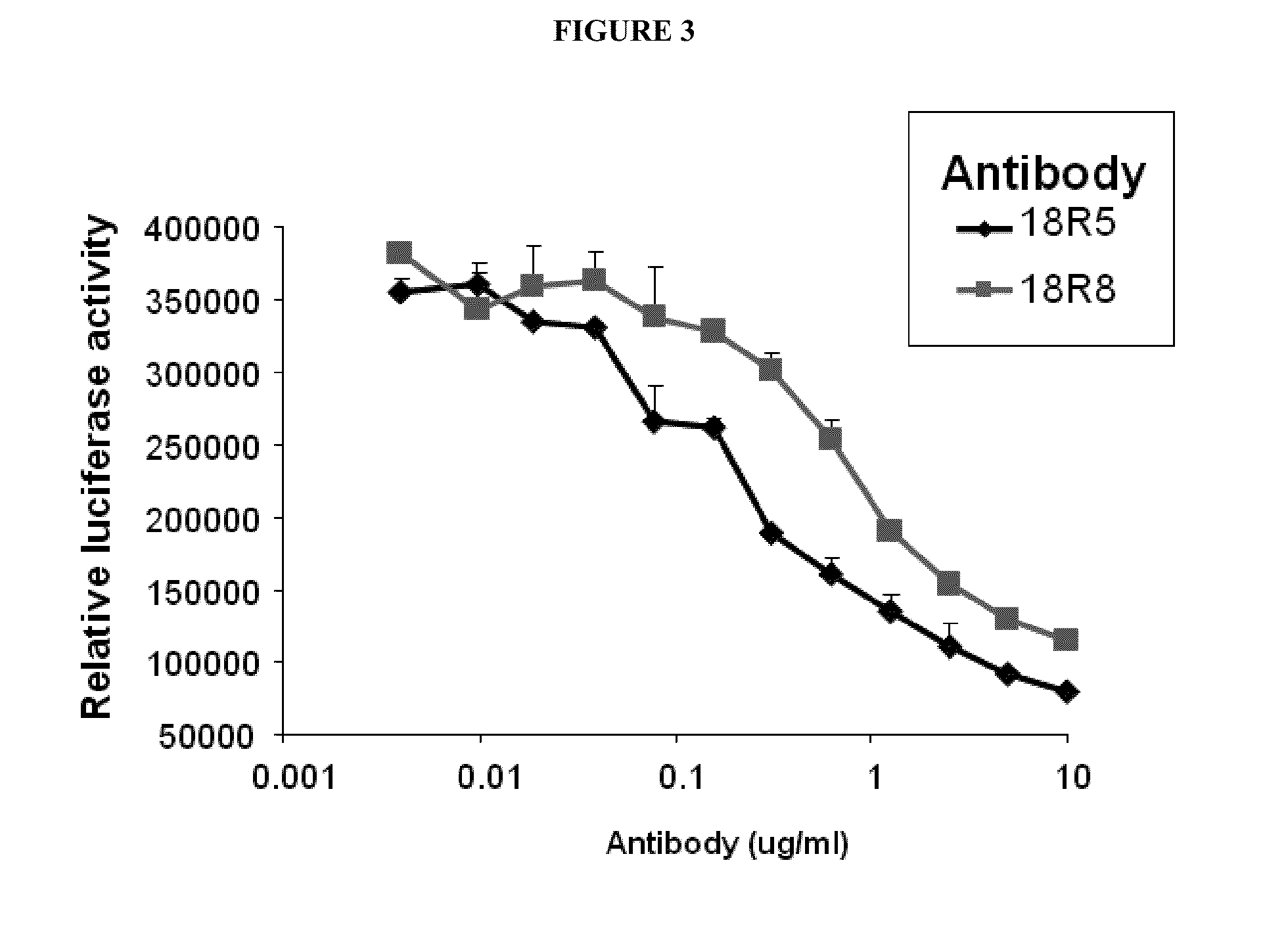Frizzled-binding agents and uses thereof
a technology of glucosamine and binding agent, which is applied in the field of glucosamine binding agent, can solve the problems of depletion of intestinal stem cell populations, and achieve the effect of reducing the growth of omp-pn4 xenograft tumors
- Summary
- Abstract
- Description
- Claims
- Application Information
AI Technical Summary
Benefits of technology
Problems solved by technology
Method used
Image
Examples
example 1
Identification / Generation of Anti-FZD Antibodies
[0307]Human antibodies that specifically recognize one or more human Frizzled receptors can be isolated using phage display. For example, a synthetic antibody library containing human antibody variable domains may be panned for specific and high affinity recognition of the extracellular domain of the human FZD7 receptor. Once a specific Fab with the desired characteristics has been identified, the human variable regions of the Fab are then cloned into an Ig expression vector containing human IgG2 heavy-chain and light-chain (kappa or lambda) for expression of human antibodies in CHO cells.
[0308]Phage display was used to identify a specific Fab, 18R8, that binds to the extracellular domain of FZD7. 2×1013 Fab displaying phage particles from a human Fab phage library were incubated with passively immobilized recombinant FZD7 ECD Fc protein. The non-specific phage were washed off, and then specific phage were eluted with DTT. The eluted o...
example 2
FACS Analysis of Anti-FZD Antibodies Demonstrates Binding to Multiple Cell-Surface Human FZDs
[0313]Flow cytometry analysis was utilized to determine the ability of antibodies to bind to cell surface expressed FZD proteins.
[0314]To enable robust cell surface expression of selected FZD proteins, mammalian expression plasmids comprising a CMV promoter upstream of polynucleotides that encode FZD were generated using standard recombinant DNA technology (such constructs were termed “FL no FLAG”). Similar expression plasmids were generated for each of the ten human frizzled proteins. Alternative versions of the FZD expression vectors were also prepared in which polynucleotides encoding an N-terminal signal sequence-FLAG epitope tag fused to the N-terminus of the mature FZD protein were also generated by standard recombinant technology (such constructs were termed “FL flag”). Additionally, expression plasmids were designed which encoded chimeric proteins comprised of either the CRD domain (...
example 3
Inhibition of Wnt Signaling by 18R8 and 18R5
[0316]The ability of the anti-FZD IgG antibodies 18R8 and 18R5 to block activation of the Wnt signaling pathway was determined in vitro using luciferase reporter assays.
[0317]STF293 cells were cultured in DMEM supplemented with antibiotics and 10% FCS. The STF293 cells are 293 cells in which the following have been stably integrated: (1) an 8×TCF Luc reporter vector containing seven copies of the TCF binding site linked to a promoter upstream of a firefly luciferase reporter gene to measure canonical Wnt signaling levels (Gazit et al., 1999, Oncogene 18:5959-66) and (2) a Renilla luciferase reporter (Promega; Madison, Wis.) as an internal control for transfection efficiency. The cells were added to cultures plates. The FZD antibodies to be tested (or no antibodies) were added. The cells were then incubated in the presence or absence of Wnt3A-conditioned medium that had been prepared from L cells that stably express Wnt3a (ATCC CRL-2647) or...
PUM
| Property | Measurement | Unit |
|---|---|---|
| Fraction | aaaaa | aaaaa |
| Composition | aaaaa | aaaaa |
| Light | aaaaa | aaaaa |
Abstract
Description
Claims
Application Information
 Login to View More
Login to View More - R&D
- Intellectual Property
- Life Sciences
- Materials
- Tech Scout
- Unparalleled Data Quality
- Higher Quality Content
- 60% Fewer Hallucinations
Browse by: Latest US Patents, China's latest patents, Technical Efficacy Thesaurus, Application Domain, Technology Topic, Popular Technical Reports.
© 2025 PatSnap. All rights reserved.Legal|Privacy policy|Modern Slavery Act Transparency Statement|Sitemap|About US| Contact US: help@patsnap.com



